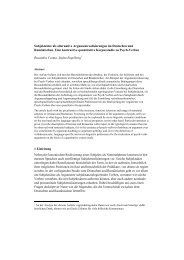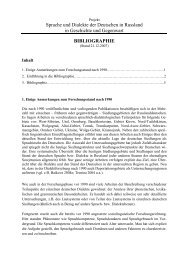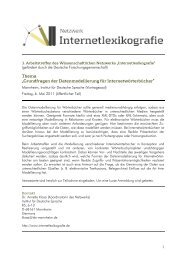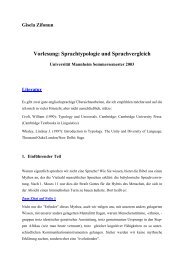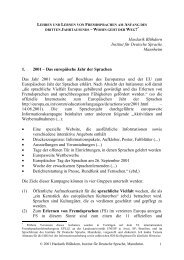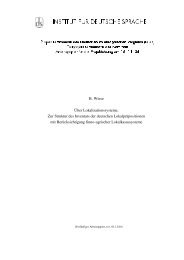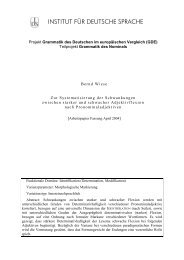Subordination and coordination in syntax, semantics and discourse ...
Subordination and coordination in syntax, semantics and discourse ...
Subordination and coordination in syntax, semantics and discourse ...
Create successful ePaper yourself
Turn your PDF publications into a flip-book with our unique Google optimized e-Paper software.
<strong>Subord<strong>in</strong>ation</strong> <strong>and</strong> <strong>coord<strong>in</strong>ation</strong>This application of the l<strong>and</strong>mark-trajector dist<strong>in</strong>ction on adverbial clausesdiffers from Langacker’s own proposal (see Langacker 1991: 436). Whenexpla<strong>in</strong><strong>in</strong>g the subord<strong>in</strong>ate status of adverbial clauses, Langacker ab<strong>and</strong>ons hisanalysis <strong>in</strong> terms of l<strong>and</strong>mark <strong>and</strong> trajector <strong>and</strong> stipulates, <strong>in</strong>stead, a generaliconicity between syntactic <strong>and</strong> semantic subord<strong>in</strong>ation <strong>in</strong> terms of profil<strong>in</strong>g (seeibid.: 436f; also Cristofaro 2003: 29ff). This solution appears somewhat ad hocto me, <strong>and</strong> Langacker himself does not expla<strong>in</strong> it. As a consequence, questionsmay also be raised about Cristofaro’s (ibid.) claim that semantic asymmetryprovides a more reliable start<strong>in</strong>g po<strong>in</strong>t for the analysis of subord<strong>in</strong>ation thantraditional morphosyntactic asymmetries do.4.2 Some formal accounts of <strong>discourse</strong> structure4.2.1 Rhetorical Structure TheoryThe hypothesis of a structural parallelism between <strong>syntax</strong>, <strong>semantics</strong> <strong>and</strong><strong>discourse</strong> has been of some importance <strong>in</strong> Rhetorical Structure Theory (RST;see Mann & Thompson 1988; Taboada & Mann 2006; Stede <strong>in</strong> this volume).RST dist<strong>in</strong>guishes between nuclear <strong>in</strong>formation <strong>and</strong> satellite <strong>in</strong>formation with<strong>in</strong>a <strong>discourse</strong>. Nuclear <strong>in</strong>formation is ma<strong>in</strong> <strong>in</strong>formation, satellite <strong>in</strong>formation issecondary <strong>in</strong>formation. The difference between them becomes clearest whenthey are deleted. The deletion of nuclear <strong>in</strong>formation will make the <strong>discourse</strong>less coherent, the rema<strong>in</strong><strong>in</strong>g parts becom<strong>in</strong>g more difficult to comprehend. Thedeletion of satellite <strong>in</strong>formation will make the <strong>discourse</strong> less explicit, but therema<strong>in</strong><strong>in</strong>g <strong>in</strong>formation will still be coherent. Thus, the omission of satellite<strong>in</strong>formation may play an important role <strong>in</strong> summariz<strong>in</strong>g (see Mann & Thompson1988: 267f).RST dist<strong>in</strong>guishes between two types of relations: nucleus-satellite relations <strong>and</strong>nucleus-nucleus relations. The former are hierarchical, the latter are nonhierarchical(Mann & Thompson 1988: 246ff, 266). Nucleus-satellite relationsare more frequently dealt with <strong>in</strong> RST-related studies. The examples analysed byMann & Thompson (ibid.: 252, 261ff) show that they can be encoded by bothcoord<strong>in</strong>ative <strong>and</strong> subord<strong>in</strong>ative connections <strong>in</strong> <strong>syntax</strong>. Both nuclear (N) <strong>and</strong>satellite (S) <strong>in</strong>formation can be encoded by both ma<strong>in</strong> (M) <strong>and</strong> adverbialsubord<strong>in</strong>ate clauses (A):(28) I’ll post more details later (S–M), but this is a good time to reserve theplace on your calendar (N–M). (concessive relation; coord<strong>in</strong>ativeconnection)© 2007 Hardarik Blühdorn, Institut für Deutsche Sprache, Mannheim. 21


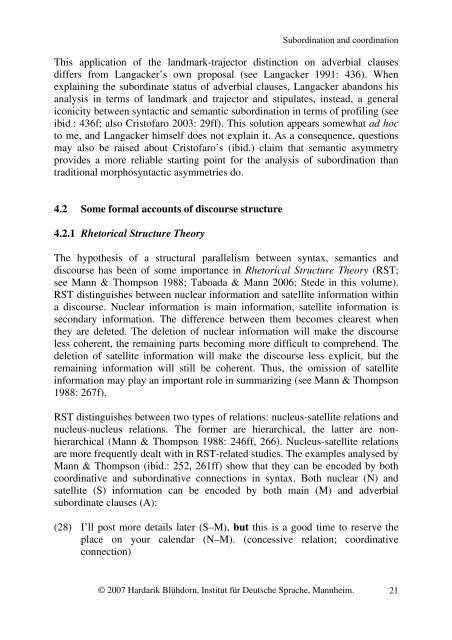
![Ãœbersetzungen-19[1]. - Institut für Deutsche Sprache](https://img.yumpu.com/51701205/1/184x260/aoebersetzungen-191-institut-fur-deutsche-sprache.jpg?quality=85)


